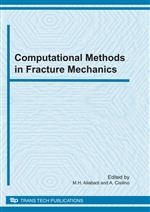Engineering Research
Materials Science
Engineering Series
Computational Methods in Fracture Mechanics
Description:
The existence of crack-like flaws cannot be precluded in any engineering structure. At the same time, the increasing demand for energy- and material-conservation dictates that structures be designed with smaller and smaller safety factors. Consequently, accurate quantitative estimates of the flaw-tolerance of structures are of direct concern to the prevention of fracture in load-bearing components of all kinds: ranging from space satellites and aircraft to bone prosthesis and home appliances.
Purchase this book:
Info:
Review from Ringgold Inc., ProtoView:
The nine papers invited to join this volume describe numerical methods for analyzing the path and growth of cracks in structures, particularly the boundary element method (BEM), finite element method (FEM), and meshless methods. Researchers at the University of Seville apply the energy domain integral to three-dimensional interface cracks in transversely isotropic bimaterials, and the applied mechanics department at the University of Erlangen-Nuremberg investigates the influence of crack surface roughness on the behavior of cracks. Other topics include a variational technique for element free analysis of fracture mechanics, symmetric-Galerkin boundary element analysis of dynamic stress intensity factors, and the numerical Green's function extended to the local boundary integral equation.

